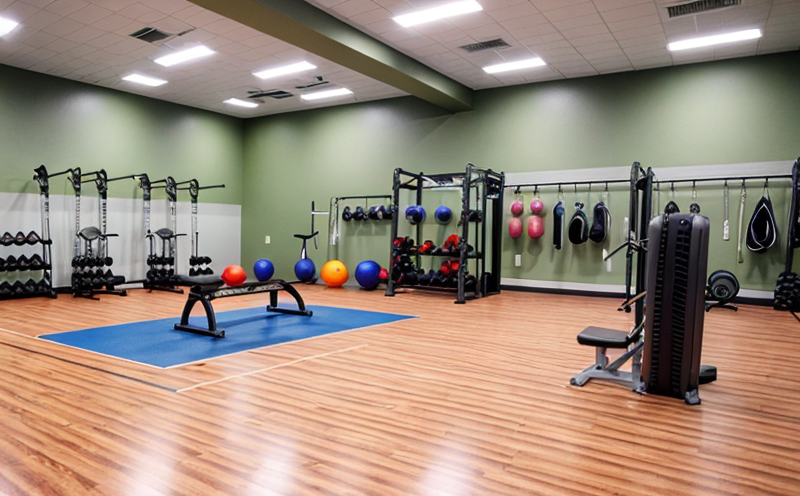Fatigue Testing of Gym Equipment Components
Fatigue testing is a critical component in ensuring the safety and longevity of gym equipment. This process involves subjecting materials or components to repeated loads over time, simulating real-world usage conditions that can lead to failure. The goal is to determine the number of cycles (or load applications) before failure occurs, thereby providing insight into the durability and reliability of a component.
For sporting goods and fitness equipment testing, fatigue testing is particularly important because these products are exposed to high levels of stress during frequent use by multiple individuals. Components such as resistance bands, pulleys, and structural frames undergo significant cyclic loading which can lead to wear and eventual failure if not properly designed and manufactured.
The process begins with selecting the appropriate specimen for fatigue testing based on the specific part or component being evaluated. This could include a metal bar from a weight stack or a plastic handlebar used in resistance training machines. Proper selection ensures that the test accurately reflects real-world conditions without introducing extraneous variables.
Once specimens are chosen, they undergo rigorous preparation which includes cleaning and conditioning to remove any surface contaminants that might affect the outcome of the test. After preparation, testing equipment such as universal testers or fatigue testing machines with appropriate fixtures are used to apply cyclic loads at controlled rates until failure occurs.
During this process, various factors need careful monitoring including stress levels, strain measurements, and temperature changes which may influence performance. Advanced sensors within the machine provide real-time data that helps technicians assess how well materials hold up under repeated use conditions.
The resulting fatigue life data provides valuable information about the expected lifespan of each component when exposed to typical usage patterns in gyms or other fitness facilities. This allows manufacturers and quality managers to make informed decisions regarding design improvements, material selection, and production processes aimed at enhancing product performance and safety.
Understanding these aspects is crucial for ensuring that consumers receive products that not only meet but exceed expectations set by industry standards like ISO 9001 or ASTM F2685.
| Component | Expected Cycles Before Failure (Approximate) |
|---|---|
| Metallic Weight Stack Bar | Over 1 Million Cycles |
| Plastic Resistance Band | Up to 50,000 Cycles Depending on Material Quality |
| Pulley System Components | At Least 200,000 Cycles for High-Quality Materials |
These figures highlight the importance of fatigue testing in maintaining high standards within the consumer products sector. By incorporating this service into their quality assurance protocols, companies can significantly reduce risks associated with equipment failure while enhancing overall user satisfaction.
Why It Matters
Fatigue testing is essential because it helps identify potential weaknesses in gym equipment components before they become critical issues. Without such tests, there’s a risk that flaws could go unnoticed until the product reaches end-users where they might result in accidents or premature replacement costs for both manufacturers and consumers.
For quality managers responsible for overseeing production processes, fatigue testing ensures compliance with relevant regulations and guidelines set forth by organizations like ASTM International. These standards help maintain consistent quality across all products produced by a company, fostering trust among customers who expect reliable performance from their investments in fitness equipment.
Compliance officers benefit greatly from this service as well since it allows them to stay ahead of regulatory changes and potential recalls due to safety concerns. By proactively addressing these issues through comprehensive testing programs, companies can avoid costly legal disputes and negative publicity associated with product failures.
R&D engineers play a key role in developing innovative solutions that meet both performance requirements and cost constraints. Fatigue testing enables them to refine designs iteratively by identifying areas where improvements are needed based on empirical evidence rather than guesswork alone.
Lastly, procurement teams can leverage the insights gained from fatigue tests when sourcing materials for new products or updating existing ones. They gain better understanding of which suppliers deliver superior quality components that contribute positively towards achieving desired outcomes in terms of durability and reliability.
Industry Applications
- Metallic weight stack bars used in multi-gyms
- Plastic handles found on resistance training machines
- Pulleys integral to exercise equipment like pull-down stations
- Treadmill decks which experience continuous mechanical stress during operation
- Bench press supports that must withstand repeated heavy loading cycles
The application of fatigue testing extends beyond just fitness equipment into other sectors such as automotive parts where components like engine bolts or suspension arms are subjected to cyclical forces similar to those experienced by gym users. This ensures not only the safety and longevity of sporting goods but also contributes positively towards environmental sustainability goals by reducing waste from early failures.





